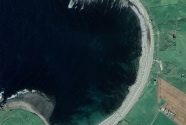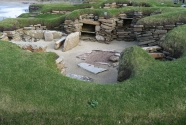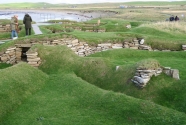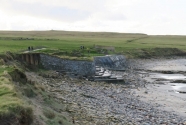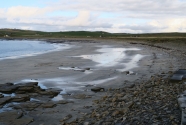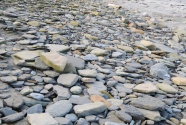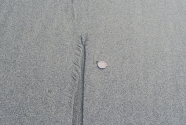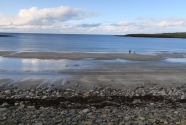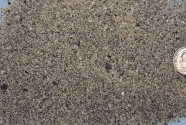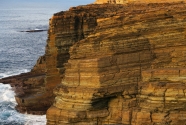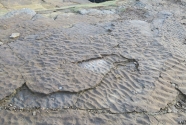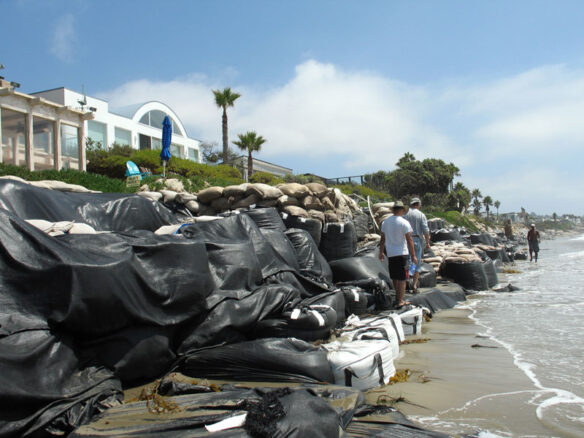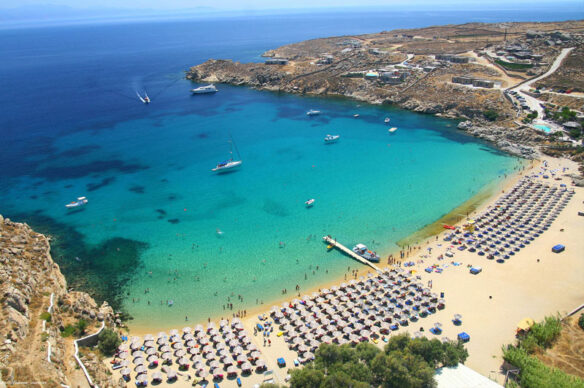
By William J. Neal Department of Geology, Grand Valley State University, Allendale, Michigan
Perceptions based on the present – what we see, hear, feel at the moment – bias our perception of the past and future. A static view of our environment is misleading. The human association with water, particularly shorelines, is a case in point. We do not perceive the history of place, and globally we occupy sites as if they are unchanging, not realizing that in fact they are of high risk. The following are the author’s impressions and personal discoveries from a couple of hours’ visit to Skara Brae, Scotland, site of a Neolithic village with origins going back 5000 years. This UNESCO World Heritage Site abounds in mystery, secrets yet to be discovered, and lessons to be derived. The poet, George Mackay Brown’s words, that the “sea gives and takes” reflects the history of Skara Brae’s discovery, partial loss, and is visionary in that the latter continues. Skara Brae, along with several other important archaeological sites in the Orkney Islands, are now in the “sea takes” category. Skara Brae is now on the shore of Skaill Bay, Mainland, Orkney Islands, just off the northern coast of Scotland (Figure 1). The crescent-shaped beach at the head of the bay is subject to a high tidal range, and during Atlantic storms the shore is battered by very high wave energy (Figure 2). At spring low-tide there is a wide beach, but during the high tides the beach can be completely inundated. In 1850 a storm erosion at the back of the beach exposed some of the houses of the old Neolithic village, roofless but otherwise intact (Figures 3 and 4). The land owner initiated an excavation that continued until 1868, after which the site remained undisturbed, except for being raided for artifacts in 1913. The sea again took a bite out of the site during a 1924 or 1925 storm that destroyed one of the houses. The first-generation protective seawall was then built in the late 1920s, and has since been reinforced several times (Figure 5).“The sea gives and takes. The sea Devoured four houses one winter.” — Excerpt from “Skara Brae” by George Mackay Brown (1921 – 1996)
“The environmental setting of the village when first constructed has been determined to be well away from the ocean shore, behind protective dunes… ” — William J. NealIn viewing the village, one’s first impression is “why would they build their houses in such a hazardous place?” (Figures 4 and 5). But we must flash back from 5000 years ago to present in order to understand how the site came to be at the mercy of the waves. The environmental setting of the village when first constructed has been determined to be well away from the ocean shore, behind protective dunes, and near a freshwater lake. By that time, the rapid post-ice-age sea-level rise had slowed, but sea level was still rising. And the climate was changing. Very likely, the ocean shoreline was moving up the valley that is now the bay, and some archaeologists suggest that over time, the village was abandoned, perhaps because of storms moving sand dunes over the structures, as well as changes in the culture. In the sense of “the sea gives,” the dune burial preserved the village. Some millennia later, as the bay extended landward, the sea gave again when the 1850 storm revealed some of the village, before beginning the processes of “taking” by eroding the site. Visiting the site during a low-spring tide reveals a beautiful beach; one in which the sediment distribution reflects the energy gradient of storm waves (Figure 6 and 7). The steep slope of the beach is apparent from atop the bluff, with cobble to boulder sized, flat flagstones at the uppermost back beach, a zone of more rounded cobbles to boulders at the base of the back beach, and the wide sandy inter-tidal beach on which ridges and runnels have developed (Figures 7 and 8). The flat flagstones are derived in part from the bedded sandstone outcrops that cross the beach (Figures 9 and 10). This island’s west coast is made up primarily of Devonian age sedimentary rocks, the “Old Red Sandstone”, which consists of these bedded sandstones and siltstones that have been referred to as ‘flagstones’ since the early days of quarrying, and are still used in construction. The flat stones in the walls of the Skara Brae houses were of the same origin, 5000 years ago. The low-tide beach is a wonderful canvas on which a variety of bed forms have developed from waves and currents. Ripple marks can be seen in the runnels (troughs) as they drain, and the water-saturated sand from high tide drains during low tide, giving the beach mirror-like watery patches (Figure 8), and forming tiny rill marks from seeps (Figure 11). In places, one can see stripes of light and dark on the beach from truncated antidunes that formed during the falling tide (Figure 12), and beach cusps on a grander scale. The beach sand is generally fine to very fine, and poorly sorted with very small pebbles of dark gray siltstone. The light gray color of the beach reflects the varied sand composition (Figures 13 and 14), which includes a surprising amount of calcareous material from microscopic shells and skeletal fragments (e.g., clams, snails, forams, echinoid spines, and a lot of unidentifiable material). The darker shade is derived from black sand-sized rock fragments and mineral grains including biotite mica. Quartz grains are also common. Not far from Skara Brae are other ancient sites (e.g., Maeshowe, Stones of Stenness, the Ring of Brodgar), but for this geologist the nearby Yesnaby coast was the highlighted contrast to Skara Brae beach. Yesnaby is a sheer rock coast – beachless with sea cliffs, stacks and arches. All cut in the “Old Red Sandstone” sequence including the Stromness Flagstones (Figure 15) in which one can find ancient ripple marks (Figure 16) and mudcracks on the bedding planes of these ancient lake deposits. And local beds contain fish fossils of the kind first described by Hugh Miller and his contemporaries in the 19th Century, in the days of the development of the science of geology in the British Isles. For this author, Skara Brae was a place of discovery, that former civilizations did retreat in the face of climate change and associated hazards, that a poet understood better than most that the “sea gives and takes”, that there are a few places like Skara Brae where a seawall is justified (even there the wall contributes to nearby erosion), and, along with its Orkney sister sites, this Neolithic village is an example that a shoreline can be a reservoir to be ‘mined’ for knowledge rather than sand.
Figure Captions
- Figure 1. Outline map of the Orkney Islands at the northern tip of Scotland (circled area of UK inset map at lower right). The islands are at the boundary of the Atlantic Ocean (left) and the North Sea (right). The star marks the approximate location of Skaill Bay and Skara Brae on the western shore of ‘Mainland’, the largest of the islands.
- Figure 2. Google Earth image of crescent-shaped Skara Brae Beach at the head of Skaill Bay during low tide. Rocky headlands yoke the beach, and are probably a partial source for the beach sand which is mostly derived from reworking of earlier beaches and sand dunes that formed when the shoreline was seaward of its present position. Even in the satellite image the strong cuspate pattern along the beach is apparent, and one can discern a ridge and runnel pattern. The remnants of Skara Brae village lie atop a cliff/bluff of bedrock, capped by old sand dunes (lower left).
- Figure 3. Skara Brae’s Neolithic structures were preserved by being buried by sand dunes after their abandonment around 2200 B.C. The stone walls were constructed without cement, but the design and construction created below-ground dwellings that were water-proof. The furniture also was stone. Note people on beach (upper left) which gives perspective that village site is at top of bluff.
- Figure 4. Skara Brae structures. Note the beach in background (top), and the far bluff of dune sand that is retreating under the influence of storm wave erosion, exacerbated by the rising sea level. Brown wrack line on beach is from high spring tide. Note offset in shore line is past the position of the old village structures, now protected by a seawall (Figure 5)
- Figure 5. The seawall protecting the archaeologic site was constructed in the late 1920s after a storm had destroyed one of the houses in 1924 or 1925. The natural shoreline position has retreated past the line of the seawall. The erosion rate at the ends of the seawall has probably accelerated due to refracted wave energy.
- Figure 6. Skara Brae beach at low tide shows the ridge (outer bar) and runnel (trough) system. The water drainage is back flow from runnels that breaches the outer bar, as well as ground water draining from the beach. The brown wrack line in the foreground marks the level of the last high tide. Note the steep upper beach on which cobble to boulder sized material has been concentrated by storm waves, with flatter flagstones at top, and more rounded stones lower on the beach.
- Figure 7. View looking down the steep beach face from the sand dune cover to the flagstone zone, then rounded cobbles and small boulders, to the intertidal sandy beach. This sediment size/shape distribution reflects the energy gradient of storm waves. The largest storm waves toss the flat flagstones and slabs (cobbles to boulders) to the base of the eroding dune face, with a zone of more rounded stones in the same size range just seaward of the flagstone zone.
- Figure 8. This view of the low-tide beach also shows the size-sorting pattern as well as the character of the sandy beach. Standing water in the runnels and water seeps along the mid-beach face produce mirror-like surfaces.
- Figure 9. Close-up of the flagstones. The similarity of these beach rocks and the construction materials of the Neolithic structures are obvious. Given that a similar beach would have been farther from the village site at the time it was occupied, the convenience of the shape of the stones would have made their transport worthwhile.
- Figure 10. The beach outcrop of a rock unit producing flagstones explains in part the source of these rocks on the upper beach. But some of the beach materials probably have come from the erosion of the nearby headlands.
- Figure 11. In addition to the larger drainage patterns on the beach (Figure 8), the micro drainage produces smaller bedforms as water seeps from the beach. Rill marks are like micro-canyons cut by the running water. Small 20p coin for scale.
- Figure 12. Note the striped pattern (dark and light) at the back of the sandy beach (mid-photo). This pattern of truncated anti-dunes forms by wave swash/backwash on the falling tide, and is a fairly common bed pattern on high-energy beaches.
- Figure 13. The light gray color of the beach sand is due to a fairly high content of dark-colored sand grains. The sand is poorly sorted, but generally fine to very fine in grain size, with some coarser granule to small pebble-sized rock fragments of dark gray siltstone. Dime for scale.
- Figure 14. A microscopic view of the beach sand shows a surprising amount of calcareous material derived from shelly organisms; the white chalky grains, as well as very fine fragments of thin shells. Whole microscopic snails, clams, and possibly forams were noted. The darker grains include sand-sized rock fragments and mineral grains including black biotite mica. Scale divisions equal mm.
- Figure 15. The sea cliffs at Yesnaby include the beautiful Stromness Flagstones formation which consists of moderately thin beds (flags) of sandstones and siltstones, part of the “Old Red Sandstone” sequence (Devonian). Not far from this location is a unit containing fish fossils for which the “Old Red” became famous for all over the British Isles in the mid-19th Century.
- Figure 16. Ripple marks on the bedding planes of these sandstones and siltstones formed around 400 million years ago when these sediments were deposited in an ancient lake basin. These bedforms are not unlike the ripple marks you might find today on the beach at Skara Brae.
References
- Fraser, R., 2001, George Mackay Brown and the Orkney Islands.The Sewanee Review, 109 (4), 564-73.
- TGeologic map
- Markham, A., 2017, Heritage at Risk: How Rising Seas Threaten Ancient Coastal Ruins.
- Miller, H. 1841, The Old Red Sandstone, or, New walks in an old field (1st ed.). John Johnstone, Edinburgh.
- Sargent, G., 2019, Climate change endangers Scotland’s archaeological treasures. World News, October 10, 2019
- Wilson, P., (editor), 2005, Building with Scottish Stone. Scottish Executive National Science Institute, Arcamedia, Edinburgh, 64p.



